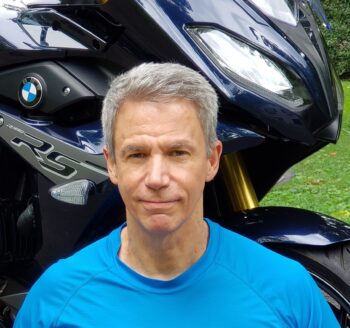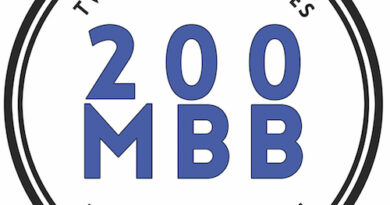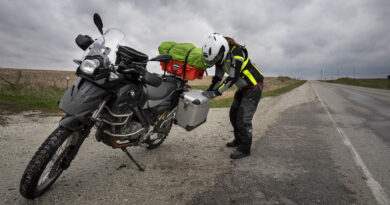When is a day not a day?
The answer is sad, and all too familiar to many of us: When the next day is a week—or two weeks or three months—away. Of course, I’m talking about riding days, especially those with spectacular weather, or those featuring a convergence of rare and irregular factors, like several riding buddies being off work simultaneously. When such a day must be sacrificed, the loss is far greater than one square on the calendar page. It can be more like missing a full moon, or maybe even some sort of eclipse! There may have been a long stretch of yearning and anticipation leading up to it, and now there will be another agonizing wait for the next opportunity of like kind—with no joyous event in between. What a difference a day makes!
The Ride Inside with Mark Barnes is brought to you by the MOA Foundation. You can join the BMW Motorcycle Owners of America quickly and easily to better take advantage of the Paul B Grant program mentioned in this episode.
 Where I live in east Tennessee, October is almost always the best month for riding a motorcycle. Summer’s sweltering heat has given way to wonderfully mild temps, rain is virtually absent from forecasts, and the nearby Appalachian Mountains are covered in brilliant plumage befitting a picture postcard. The days have grown shorter, but still last long enough for satisfaction. Forfeiting just one weekend’s ride during this month of moto-bliss represents a hefty 25% subtraction. Miss two and you’ve reduced the prime-time fun by half. You know where this is headed: I missed all four this year. These didn’t include epic travel plans or exotic adventures; I merely aspired to spend one long afternoon in the saddle each weekend as I counted down the hectic days of work, errands, chores and meetings crowding my Monday through Friday schedule. In a universe where life is fair, this wouldn’t be too much to ask.
Where I live in east Tennessee, October is almost always the best month for riding a motorcycle. Summer’s sweltering heat has given way to wonderfully mild temps, rain is virtually absent from forecasts, and the nearby Appalachian Mountains are covered in brilliant plumage befitting a picture postcard. The days have grown shorter, but still last long enough for satisfaction. Forfeiting just one weekend’s ride during this month of moto-bliss represents a hefty 25% subtraction. Miss two and you’ve reduced the prime-time fun by half. You know where this is headed: I missed all four this year. These didn’t include epic travel plans or exotic adventures; I merely aspired to spend one long afternoon in the saddle each weekend as I counted down the hectic days of work, errands, chores and meetings crowding my Monday through Friday schedule. In a universe where life is fair, this wouldn’t be too much to ask.
Turns out, I don’t live in that universe.
A tsunami of urgent work-related demands drowned weekend number one in short order. While deeply disappointing, this seemed like an acceptable casualty, given the fact three additional weekends still remained. Unlike a literal tsunami, that huge wave of work refused to peak and retreat; weekend number two was under serious threat. I mounted the best resistance I could muster, cordoning off several hours for a late Sunday afternoon spin on a spiderweb of empty backroads in the neighboring countryside. I refused to give up that little wedge of sacred ground! A mere 14 miles out, however, amidst the bucolic desolation of an adjacent county, my bike suddenly quit running. Fortunately, I was riding with a friend who owns a trailer and could go home, get it and return and get me, all in less than an hour—pretty good luck, as breakdowns go. (“Breakdown” is really too strong a word for what happened, as subsequent diagnostic investigations revealed the problem to be an ever-so-slightly loose electrical connector that could have been pushed securely into place without a single tool in less than a minute, had been apparent at the time. Instead, it had looked perfectly plugged in during my admittedly agitated roadside inspection.) During the otherwise unbroken silence while I sat awaiting rescue, a hawk circled overhead and voiced my emotions with its mournful screech. With less than 30 minutes of wheels turning, half my October was now spent.
Most fortunately, a friend gifted in the mechanical and electronic arts volunteered to get my motorcycle running again. I had imagined the next weekend might have to be spent in the garage instead of in the saddle. For me, that’s often not such a terrible alternative, since I love turning wrenches and solving mysteries, but I’d much rather do that when the weather isn’t sublime. It took him several hours to discover the culprit, since he began searching for more serious problems and had also thought the incompletely plugged plug looked just fine at first glance. Even highly skilled people occasionally overlook something simple in their search for something complex. I’m sure the same process would have consumed a whole day for me, but I was spared that fate and it seemed I might yet claim a day of riding before October’s end. After all, the glass was still half-full. (On the other hand, learning my failed ride actually could have easily resumed with barely a pause made its loss sting more.)

If the work demands that wiped out weekend number one were a tsunami, the firestorm of crises that came next must have been analogous to the asteroid impact that ended the age of the dinosaurs. The return of my revived motorcycle was rendered absolutely moot as I dealt with another barrage of unexpected requirements in my day job, health issues of my own and those close to me, car malfunctions, a plumbing emergency, and a mandatory professional seminar on the Saturday of weekend three. I was exhausted and demoralized, heartbroken over having yet another weekend of stunningly gorgeous weather snatched from my grasp, with riding buddies beckoning on a near-daily basis. As I’ve already foretold, the fourth weekend was a non-starter, too, with a surprise family obligation landing squarely in the middle of it and precluding any meaningful outing on either edge.
The month I look forward to each autumn as the pinnacle of my (virtually) year-long riding season had come and gone without a single hour of good riding, and it may have been the finest October ever, with uncannily consistent conditions. Sure, there will be some nice days in November—and possibly even December—but will they align with my days off? I have plenty of gear to allow riding in reasonable comfort on all but the worst days of winter here, but the mountainsides will be a dreary grayish brown, mobility on the bike will be restricted by the extra layers, and late afternoon will be the new dusk. I’m certainly fortunate to be able to ride some in January and February, but there’s still cause to long for spring. Even then, the glorious days of April and May will be frequently interrupted with showers, and June is a dodgy mix of pleasant warmth and wicked heat and humidity. Everyone knows what summer in the deep south is like, and that includes a big chunk of September. No, nothing compares to October here. Missing this one means a two-year span between the last one and the next one.
Finitude is the existential reality we are constantly crashing against—and also constantly denying. We have only so much time each day, each week, each lifetime. This forces us to make choices about how we’ll spend our limited resources. We can make such choices consciously, carefully, and deliberately, doing our best to select the activities that matter most to us, or we can ignore the gravity of this dilemma and choose haphazardly, thoughtlessly, and as though we have infinite time to do everything on our lists, regardless of what we tacitly prioritize or procrastinate. Obviously, this isn’t the truth of our situation. Oliver Burkeman’s book, Four Thousand Weeks: Time Management for Mortals, delivers a sobering confrontation on this count. If we take seriously the fact an average human life is comprised of a mere 4,000 weeks (at least half of which have probably passed by the time we notice this), each one becomes much more precious. The limit of death is a big part of what gives our choices meaning. If we really did have eternity at our disposal, there’d be little urgency to do anything, since it could always be done another day without penalty.

Burkeman critiques the famous time management guru Stephen Covey, who, in his book, First Things First, made the following analogy. If our to-do list were represented by rocks, gravel and sand, with the size of each corresponding to its importance, and our time was a jar into which we had to fit them, it would be essential to put the rocks in first. Doing so would allow the rest to be added later, filling in the cavities and remaining space at the top. Alternatively, if we put the gravel and sand in first, we’d find it impossible to squeeze in the rocks later. It’s a clever image, but it fails miserably as a representation of real life. As Burkeman so accurately points out, the excruciating experience of actual human beings is there are far too many rocks to fit in the jar to begin with, regardless of how efficiently we arrange the various components. We must not only jettison activities of low priority to make room for higher value inclusions, but also forego matters of truly high priority. We can make such sacrifices purposefully, grieving the losses as we go, or we can passively allow death and other time limitations to lop off whatever items we didn’t actively move to the very top of our list. We lose a great deal either way, but when we choose consciously, we take on the weighty responsibility of prioritizing some things over others in recognition of our terribly finite temporal allocation. When we don’t do this, we avoid both the associated responsibility and the acknowledgement of our all-too-real limitations.
It’s no wonder the vast majority of us operate in the latter mode, as nobody wants to live in the perpetual shadow of our own finitude, accepting the inevitability of relinquishing thoroughly unrealistic aspirations of one day getting to the bottom of our endless to-do lists, and owning the painful fact we will prove unavoidably frustrating and disappointing to very important people in our lives. There isn’t enough efficiency in the world to allow a different outcome, and we can burn up all the time we have frantically chasing this outlandish ideal, or we can turn a blind eye to the associated realities and blithely let circumstances decide what we won’t get done. The third option, which is the most emotionally arduous, Burkeman asserts as the basis of a life well-lived: we make informed decisions with our eyes open, bravely and mindfully pursuing that tiny sliver of our ambitions we might accomplish in what little time we actually have available (which is, of course, always uncertain, even when using a statistically realistic forecast).
At 63 years old, I’ve already used about 3,300 of my 4,000 weeks. While I cling to inspiration from motorcyclists who’ve ridden into their 80s, I also realize they’re the exceptions. If I can continue riding for the next 12 years, I’ll count myself very lucky. That’s just 624 weeks, or 144 months, only 12 of which will be Octobers. The October I just missed was (at least) 8% of my remaining allotment, and it was completely eradicated by the loss of just four days. Those days amounted to much more than their miniscule space on the calendar.

I’ve written before about the necessity of formally scheduling riding time into our busy lives, just like we would do with essential business meetings, medical appointments, and treasured social gatherings. It might seem like I didn’t take my own advice, and maybe I could have protected some small corner of my month more vigorously, especially if I’d known how the rest of it would play out. But there’s another aspect of this I want to highlight: when life is an avalanche of triage situations, genuinely high-priority items, as riding is for me, must be forfeited. That’s the awful truth in Burkeman’s book. It is a profoundly lamentable fact of life. However, recognizing this and grieving it can stiffen our resolve going forward, prompting us to take initiatives more deliberately, wherever feasible, to forego lesser priorities in favor of greater ones. There’s no way to avoid sacrificing things we truly value, but we can do so thoughtfully.
Mark Barnes is a clinical psychologist and motojournalist. To read more of his writings, check out his book Why We Ride: A Psychologist Explains the Motorcyclist’s Mind and the Love Affair Between Rider, Bike and Road, currently available in paperback through Amazon and other retailers.



